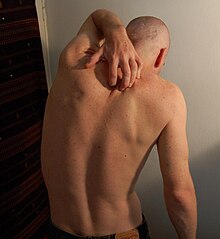itching
| Classification according to ICD-10 | |
|---|---|
| L29 | Pruritus |
| F45.8 | Other somatoform disorders Psychogenic pruritus |
| ICD-10 online (WHO version 2019) | |
Itching or pruritus (from Latin prurire , dt. Itch ) is an unpleasant sensation of the skin , which is scratching, i.e. rubbing, rubbing, etc. of the skin with the ends of the fingernails or other suitable materials or mechanical aids (e.g. back scratches ) provoked. Itching can be a symptom of a medical condition. The changes in the skin (scratch artifacts) caused by scratching appear as line or surface redness, bleeding spots (with subsequent incrustation ), hyperpigmentation , lichenification and pyoderma . According to a study, around 70% of pruritus patients also suffer from psychosomatic or psychiatric illnesses .
The messenger substances (mediators) that trigger the itching, e.g. B. Histamine , which is released by mast cells , among other things , can also be released by drugs (e.g. hydroxyethyl starch ), food, allergens , plant or insect poisons and the like. Chronic forms of pruritus are often resistant to therapy.
In the past, it was often assumed that itching as a subliminal pain stimulus on the skin is perceived by the same receptors as pain and that it is transmitted via the same signaling pathways. Recent research into histamine-mediated itching blames nerve fibers of the skin that cannot cause pain. In addition, there are obviously separate signaling pathways for pain and itching. The gastrin releasing peptide (GRP) and the natriuretic polypeptide b (Nppb) appear to be important transmitters for itching .
Similar to pain, itching is associated with memory. This means that people with chronic pruritus perceive itching at a lower level. Itching is also contagious via mirror neurons - an effect that also occurs when yawning .
to form
Pruritus cum materia is itching that accompanies skin diseases such as B. atopic eczema , dermatomycosis , psoriasis or urticaria .
Pruritus sine materia is itching without primary visible changes in the skin, which can indicate the disease of internal organs (e.g. cholestasis syndrome and primary biliary cholangitis due to an increase in bile acids in the blood plasma, renal insufficiency , uremia , diabetes mellitus , leukemia , lymphomas , malignant tumors ) or in around 50% of cases without detectable triggering factors ( idiopathic ), for example in the form of aquagenic pruritus .
Senile pruritus or itching of old age is due to dry skin caused by age-related degenerative changes in the skin.
Pruritus ani is itching in the area of the anus .
As neuropathic pruritus itching is referred to, by compression or degeneration of nerve fibers occurs. This is or can be the case with the following diseases, among others: Notalgia paraesthetica (on the back), Cheiralgia paraesthetica (on the hand), Meralgia paraesthetica (on the thigh).
Uremic pruritus is very commonwith kidney failure and hemodialysis . The cause is not clearly understood, but chronic polyneuropathy , uremic skin changes and chronic inflammation play a role.
treatment
In addition to the treatment of any underlying disease and basic measures such as skin care, symptomatic u. a. be treated with H1 antihistamines . Opioid antagonists ( naltrexone ) were successful according to a study. Cooling helps with local itching. In some cases, warm water also helps, but this can lead to dry skin and itching itself again. Therapy with UVB rays is also used.
Web links
Individual evidence
- ↑ a b c d R. Leinmüller: Pruritus: Even with chronic itching there is a “memory”. In: Deutsches Ärzteblatt. 103, Issue 1-2, January 9, 2006, pp. A-22 / B-16 / C-16.
- ↑ Who cares? In: Spectrum of Science. 10/07, p. 12.
- ↑ Yan-Gang Sun, Zhou-Feng Chen: A gastrin-releasing peptide receptor mediates the itch sensation in the spinal cord. In: Nature. 448, 2007, pp. 700-703. doi: 10.1038 / nature06029 .
- ^ SK Mishra, MA Hoon: The Cells and Circuitry for Itch Responses in Mice. In: Science. 340, 2013, pp. 968-971. doi: 10.1126 / science.1233765 .
- ↑ a b S2k guidelines for diagnosis and therapy of chronic pruritus of the German Dermatological Society (in charge). In: AWMF online (as of 05/2016)
